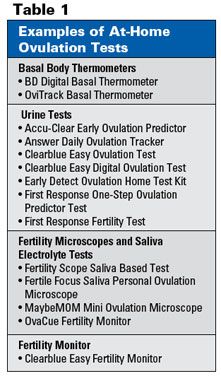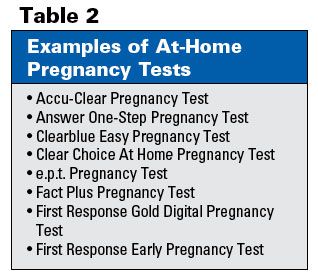Publication
Article
Pharmacy Times
Ovulation and Pregnancy Tests
Author(s):
Ovulation and Pregnancy Tests
A variety of at-home diagnostic tests
are available for detecting ovulation and pregnancy. Pharmacists can be a valuable resource for women electing to use these tests by aiding in both their selection and proper use.
Ovulation Prediction
Devices used for ovulation prediction monitor the natural hormonal changes that occur during a woman’s menstrual cycle. OTC products available for predicting ovulation include thermometers measuring basal body temperaure (BBT), urine tests, fertility microscopes, and saliva tests (Table 1). Factors that may be considered when selecting a method of testing include ease of use, patient preference, and cost.

Basal Body Thermometers
BBT is an easy way to predict ovulation time for many women. Most BBTs are available as digital models for easy reading. A woman’s BBT is typically below normal during the first part of the menstrual cycle.1 Right before ovulation, there is a slight decrease in temperature, followed by an increase of 0.5°F to 1.6°F in the basal reading due to the increase in progesterone levels.2 After ovulation, the woman’s body temperature, when taken orally, is typically 97°F to 99°F.1,2 Women electing to use this method to predict ovulation should be advised to take temperature readings at approximately the same time every morning, before rising, after at least 5 hours of sleep.1 BBT monitoring should begin on the first day of the menstrual cycle. Monitoring BBT is considered a useful tool in evaluating the menstrual cycle from month to month, so that the woman will become more aware of her ovulation patterns and be able to identify her fertile days.2 Women also should be advised that certain factors can interfere with obtaining accurate results, such as anxiety, illness, movement, and insomnia.1,2 Avoid eating, drinking, and smoking for 30 minutes before taking the BBT.1,2
Urine-Based Ovulation Tests
Urine-based ovulation tests use monoclonal antibodies specific to luteinizing hormone (LH) to detect the surge of LH.1,2 These tests should be used 2 to 3 days before estimated ovulation, and once the LH surge has been detected, testing should be discontinued. Ideally, early-morning collection is recommended because the LH is most concentrated at this time.1,2 If the test cannot be performed immediately, the urine sample should be refrigerated for testing later the same day. The sample should be returned to room temperature before testing.1,2
Women should be advised to adhere to the testing directions provided by the manufacturer and should read the testing procedure before starting the test. Medical conditions such as polycystic ovarian syndrome (POS) and menopause, which are associated with high levels of LH, may cause false- positive test results. The use of fertility medications, a patient recently discontinuing the use of oral contraceptives, or impaired hepatic and renal function also can cause false-positive results.1,2
Fertility Microscopes
Fertility microscopes are available for detecting ovulation. They are available as reusable devices that enable women to examine dried saliva samples using an illuminated microscope about the size of a lipstick container. Hormonal changes that occur before, during, and after ovulation directly affect saliva electrolyte concentrations.1 When ovulation occurs, estrogen levels rise, thus causing the amount of salt in the saliva to increase. When dried saliva samples are viewed under a microscope, a fern-like pattern can be observed during fertile periods. The fern pattern appears in test samples approximately 3 to 4 days prior to ovulation and continues until 2 to 3 days after ovulation. During a nonfertile time, nonrandom dotted lines or a bubble pattern appears.1
It is important to inform women to test daily before teeth-brushing, eating, or drinking. If the test is performed later in the day, women should be advised to wait at least 2 hours after eating or drinking so as not to alter the test results.1
Saliva Electrolyte Test
The OvaCue Fertility Monitor (Zetek Inc) measures the concentration of electrolytes in the saliva to predict ovulation. It measures both saliva sodium and potassium by an electrochemical mechanism.1,2 The patient applies a spoon-sized sensor to the tongue for 5 seconds each morning, and the monitor automatically displays and records the individual’s fertility for that day. The OvaCue keeps a record of the measurements in memory and indicates the most fertile period from 5 to 7 days before ovulation until ovulation is confirmed.1,2 In addition, a vaginal sensor can be purchased with the monitor to confirm ovulation by measuring electrolyte changes in the vaginal mucus. The data from the monitor can then be downloaded to a computer for interpretation.1,2
Women electing to use ovulation monitoring devices should be encouraged to seek medical evaluation if they fail to conceive after 3 months of using these products, and those patients with a history of medical conditions (ie, endometriosis, amenorrhea, POS) should always be referred to seek medical evaluation.1
Pregnancy Tests
Home pregnancy tests are designed to detect the presence of human chorionic gonadotropin (hCG) hormone in urine samples (Table 2). These tests use monoclonal or polyclonal antibodies in an enzyme immunoassay.1 Early pregnancy tests enable women to confirm a pregnancy and receive early prenatal care. When counseling patients about home pregnancy tests, they should be reminded to adhere to the testing protocol provided by the manufacturer, unless otherwise specified, the first morning urine should be used, because levels of hCG are most concentrated at this time. If testing takes place at another time of the day, patients should be advised to restrict fluid intake for 4 to 6 hours before urine collection.1 Most tests can be performed in an easy, 1-step procedure. The newest tests are digital and display readings of “pregnant” or “not pregnant,” which make the interpretation of results easier and more accurate.
Women should be advised that performing a test too early after a missed menstrual cycle may result in a false- negative test result, and it may be best to wait to test at least 1 week after an expected cycle. Patients obtaining a negative test result should be advised to retest if menstruation does not begin as expected, as well as be advised to seek medical evaluation from their primary health care provider for a serum hCG test and physical examination.








